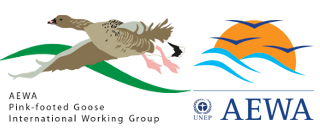Current Size: 76%
International Species Management Plan
The International Species Management Plan (ISMP) for the Svalbard population of the pink-footed goose was adopted at the 5th session of the AEWA Meeting of the Parties in May 2012, in France. It is the first of its kind for AEWA and a unique proposition in European waterbird management. It sets out to collaboratively manage and maintain the population size of this species following the principles of adaptive management.
The goal of the ISMP is:
To maintain the favourable conservation status of the Svalbard Pink-footed Goose population at
flyway level while taking into account economic and recreational interests.
To achieve this goal the following set of objectives have been established:
I. Maintain a sustainable and stable pink-footed goose population and its range.
II. Keep agricultural conflicts to an acceptable level.
III. Avoid increase in tundra vegetation degradation in the breeding range.
IV. Allow for recreational use that does not jeopardize the population.
The ISMP also details 8 key actions that are regarded as essential to fulfil the plans objectives. A stated action is to maintain the population in the long term at around 60,000 individuals. This action entails implementing a sustainable hunting strategy based on the concept of Adaptive Harvest Management. The species is hunted in Denmark and Norway. The plans also details a number of other key actions to manage conflicts and ensure that suitable habitats for the species are maintain throughout its flyway. The continued monitoring of the population, environmental conditions and impacts are also recognised as essential actions to effectively evaluate management actions.
The International Species Management Plan with its goals and objectives is to be reviewed and updated every 10 years (first revision in 2022). The Adaptive Harvest Management strategy for the species is based on a 3 year regulatory cycle, starting in 2013 and to be reviewed in time for the 2016 hunting season. For more details about predicted sustainable hunting levels please see the Adaptive Harvest Management Report.
Monitoring of the population, environmental conditions and management actions is undertaken annually and published in the Population Status Report. The overall international implementation of the Management Plan is led and coordinated through the International Working Group, supported by the Coordination Unit currently based at Aarhus University.
To access a copy of the plan, please use the following link:
The Coordination Unit has a limited number of printed International Species Management Plan for the Svalbard population of the pink-footed goose available in English. For more information, please contact the Coordination Unit.
For full picture details, please visit the credits page.
















